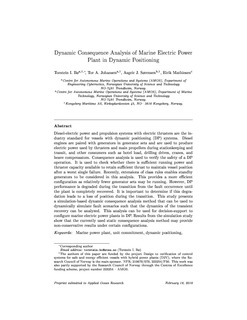| dc.contributor.author | Bø, Torstein Ingebrigtsen | |
| dc.contributor.author | Johansen, Tor Arne | |
| dc.contributor.author | Sørensen, Asgeir Johan | |
| dc.contributor.author | Mathiesen, Eirik | |
| dc.date.accessioned | 2017-12-05T12:03:56Z | |
| dc.date.available | 2017-12-05T12:03:56Z | |
| dc.date.created | 2016-05-20T13:22:51Z | |
| dc.date.issued | 2016 | |
| dc.identifier.citation | Applied Ocean Research. 2016, 57 30-39. | nb_NO |
| dc.identifier.issn | 0141-1187 | |
| dc.identifier.uri | http://hdl.handle.net/11250/2469277 | |
| dc.description.abstract | Diesel-electric power and propulsion systems with electric thrusters are the industry standard for vessels with dynamic positioning (DP) systems. Diesel engines are paired with generators in generator sets and are used to produce electric power used by thrusters and main propellers during stationkeeping and transit, and other consumers such as hotel load, drilling drives, cranes, and heave compensators. Consequence analysis is used to verify the safety of a DP operation. It is used to check whether there is sufficient running power and thruster capacity available to retain sufficient thrust to maintain vessel position after a worst single failure. Recently, extensions of class rules enable standby generators to be considered in this analysis. This provides a more efficient configuration as relatively fewer generator sets may be running. However, DP performance is degraded during the transition from the fault occurrence until the plant is completely recovered. It is important to determine if this degradation leads to a loss of position during the transition. This study presents a simulation-based dynamic consequence analysis method that can be used to dynamically simulate fault scenarios such that the dynamics of the transient recovery can be analyzed. This analysis can be used for decision-support to configure marine electric power plants in DP. Results from the simulation study show that the currently used static consequence analysis method may provide non-conservative results under certain configurations. | nb_NO |
| dc.language.iso | eng | nb_NO |
| dc.publisher | Elsevier | nb_NO |
| dc.relation.uri | http://folk.ntnu.no/torarnj/dyncap.pdf | |
| dc.rights | Attribution-NonCommercial-NoDerivatives 4.0 Internasjonal | * |
| dc.rights.uri | http://creativecommons.org/licenses/by-nc-nd/4.0/deed.no | * |
| dc.title | Dynamic consequence analysis of marine electric power plant in dynamic positioning | nb_NO |
| dc.type | Journal article | nb_NO |
| dc.type | Peer reviewed | nb_NO |
| dc.description.version | acceptedVersion | nb_NO |
| dc.source.pagenumber | 30-39 | nb_NO |
| dc.source.volume | 57 | nb_NO |
| dc.source.journal | Applied Ocean Research | nb_NO |
| dc.identifier.doi | 10.1016/j.apor.2016.02.004 | |
| dc.identifier.cristin | 1356551 | |
| dc.relation.project | Norges forskningsråd: 210670 | nb_NO |
| dc.relation.project | Norges forskningsråd: 223254 | nb_NO |
| dc.description.localcode | © 2016. This is the authors’ accepted and refereed manuscript to the article. LOCKED until 12.3.2018 due to copyright restrictions. This manuscript version is made available under the CC-BY-NC-ND 4.0 license http://creativecommons.org/licenses/by-nc-nd/4.0/ | nb_NO |
| cristin.unitcode | 194,63,25,0 | |
| cristin.unitcode | 194,64,20,0 | |
| cristin.unitname | Institutt for teknisk kybernetikk | |
| cristin.unitname | Institutt for marin teknikk | |
| cristin.ispublished | true | |
| cristin.fulltext | postprint | |
| cristin.qualitycode | 1 | |

